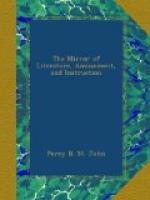TEMPLE AT ABURY.
Sermons in stones
And good in every thing.—Shakspeare.
What means the mysterious circle of stocks and stones on the other side? Such will be the question of many a lover of fun, novel, fiction, and romance; and though we cannot settle their origin with the quickness or the humour of Munden’s Cockletop, we will try to let our inquirer into the secret with the smallest show of mysticism possible.
Our engraving represents the Temple of Abury, the most extensive of all the ruins in Wiltshire, attributed to the Druids. Such was its original state, before the Vandalism of modern times destroyed and levelled much of its monumental grandeur. It consisted of a grand circle, containing two minor circles. The outer circle contained upwards of 28 acres, and was surrounded by a ditch. There was a circle within each of the two circles, contained within the circumvallation; and according to Dr. Stukely, the antiquarian, the original was thus composed:—
Outward circle, within the vallum 100 stones Northern Temple, outward circle 30 — Ditto, inward circle 12 — Cove, or cell 3 — Southern Temple, outward circle 30 — Ditto, inward circle 12 — Central Obelisk 1 — Ring Stone 1 —
The Temple occupied a spot to which there is a gradual and imperceptible ascent on all sides, and was approached by two avenues of two hundred stones each. Its general form was that of a snake, in by gone ages, the symbol of eternity and omniscience. “To make the form still more elegant and picture-like, the head of the snake is carried up the southern promontory of Hackpen Hill—and the very name of the hill is derived from this circumstance."[1]
[1] Dr. Stukely, who says,
that acan in the Chaldee signifies
a
serpent, and hac is no other than a snake.
In Yorkshire
they
still call snakes hags; and in the British language
pen
denotes a head.
The whole figure thus represented the circle, snake, and wings. By this the founders meant to picture out the nature of the Divinity; the circle meant the supreme fountain of all being, the Father; the serpent, that divine emanation from him, which was called the Son; the wings imported that other divine emanation from them, which was called the Spirit, the Anima Mundi. That the Temple was of a religious, and not of a warlike nature, is proved by its ditch being withinside the agger of earth, contrary to the mode adopted in works of defence.
Of the devastation and decay of Abury, the following data will afford some idea:
The grand total of stones, included in
the temples and avenues, was
650; in the original temples, 188.




